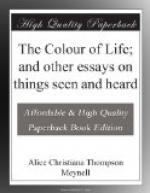So with Charlotte Bronte. Matthew Arnold seems to have thought the most probable thing to be said of her eyes was that they were grey and expressive. Thus, after seeing them, does he describe them in one of his letters. Whereas Mrs Gaskell, who shows signs of attention, says that Charlotte’s eyes were a reddish hazel, made up of “a great variety of tints,” to be discovered by close looking. Almost all eves that are not brown are, in fact, of some such mixed colour, generally spotted in, and the effect is vivacious. All the more if the speckled iris has a dark ring to enclose it.
Nevertheless, the eye of mixed colour has always a definite character, and the mingling that looks green is quite unlike the mingling that looks grey; and among the greys there is endless difference. Brown eyes alone are apart, unlike all others, but having no variety except in the degrees of their darkness.
The colour of eyes seems to be significant of temperament, but as regards beauty there is little or nothing to choose among colours. It is not the eye, but the eyelid, that is important, beautiful, eloquent, full of secrets. The eye has nothing but its colour, and all colours are fine within fine eyelids. The eyelid has all the form, all the drawing, all the breadth and length; the square of great eyes irregularly wide; the long corners of narrow eyes; the pathetic outward droop; the delicate contrary suggestion of an upward turn at the outer corner, which Sir Joshua loved.
It is the blood that is eloquent, and there is no sign of blood in the eye; but in the eyelid the blood hides itself and shows its signs. All along its edges are the little muscles, living, that speak not only the obvious and emphatic things, but what reluctances, what perceptions, what ambiguities, what half-apprehensions, what doubts, what interceptions! The eyelids confess, and reject, and refuse to reject. They have expressed all things ever since man was man.
And they express so much by seeming to hide or to reveal that which indeed expresses nothing. For there is no message from the eye. It has direction, it moves, in the service of the sense of sight; it receives the messages of the world. But expression is outward, and the eye has it not. There are no windows of the soul, there are only curtains; and these show all things by seeming to hide a little more, a little less. They hide nothing but their own secrets.




